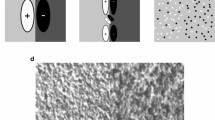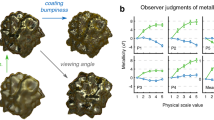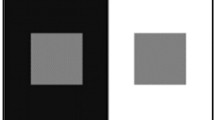Abstract
The perception of surface albedo (lightness) is one of the most basic aspects of visual awareness. It is well known that the apparent lightness of a target depends on the context in which it is embedded1,2,3,4,5,6, but there is extensive debate about the computations and representations underlying perceived lightness. One view asserts that the visual system explicitly separates surface reflectance from the prevailing illumination and atmospheric conditions in which it is embedded7,8,9,10, generating layered image representations. Some recent theory has challenged this view and asserted that the human visual system derives surface lightness without explicitly segmenting images into multiple layers11,12. Here we present new lightness illusions—the largest reported to date—that unequivocally demonstrate the effect that layered image representations can have in lightness perception. We show that the computations that underlie the decomposition of luminance into multiple layers under conditions of transparency can induce dramatic lightness illusions, causing identical texture patches to appear either black or white. These results indicate that mechanisms involved in decomposing images into layered representations can play a decisive role in the perception of surface lightness.
This is a preview of subscription content, access via your institution
Access options
Subscribe to this journal
Receive 51 print issues and online access
$199.00 per year
only $3.90 per issue
Buy this article
- Purchase on Springer Link
- Instant access to full article PDF
Prices may be subject to local taxes which are calculated during checkout



Similar content being viewed by others
References
Koffka, K. Principles of Gestalt Psychology (Harcourt, Brace and World, New York, 1935)
Gilchrist, A. L. Perceived lightness depends on spatial arrangement. Science 195, 185–187 (1977)
Gilchrist, A. L. When does perceived lightness depend on perceived spatial arrangement? Percept. Psychophys. 28, 527–538 (1980)
Knill, D. C. & Kersten, D. Apparent surface curvature affects lightness perception. Nature 351, 228–230 (1991)
Adelson, E. H. Perceptual organization and the judgment of brightness. Science 262, 2042–2044 (1993)
Eagleman, D. M., Jacobson, J. E. & Sejnowski, T. J. Perceived luminance depends on temporal context. Nature 428, 854–856 (2004)
Bergstrom, S. S. Common and relative components of reflected light as information about the illumination, colour, and three-dimensional form of objects. Scand. J. Psychol. 18, 180–186 (1977)
Gilchrist, A. L. The perception of surface blacks and whites. Sci. Am. 240, 112–123 (1979)
Barrow, H. G. & Tenenbaum, J. in Computer Vision Systems (eds Hanson, A. R. & Riseman, E. M.) 3–26 (Academic, New York, 1978)
Anderson, B. L. A theory of illusory lightness and transparency in monocular and binocular images: the role of contour junctions. Perception 26, 419–453 (1997)
Gilchrist, A. et al. An anchoring theory of lightness perception. Psychol. Rev. 106, 795–834 (1999)
Adelson, E. H. in The New Cognitive Neurosciences 2nd edn (ed. Gazzaniga, M.) 339–351 (MIT Press, Cambridge, Massachusetts, 1999)
Singh, M. & Anderson, B. L. Toward a perceptual theory of transparency. Psychol. Rev. 109, 492–519 (2002)
Rutherford, M. D. & Brainard, D. H. Lightness constancy: a direct test of the illumination estimation hypothesis. Psychol. Sci. 13, 142–149 (2002)
Anderson, B. L. The role of occlusion in the perception of depth, lightness, and opacity. Psychol. Rev. 110, 762–784 (2003)
Anderson, B. L. The role of perceptual organization in White's illusion. Perception 32, 269–284 (2003)
Anderson, B. L. Stereoscopic surface perception. Neuron 24, 919–928 (1999)
Boyaci, H., Maloney, L. T. & Hersh, S. The effect of perceived surface orientation on perceived surface albedo in binocularly viewed scenes. J. Vis. 3, 541–553 (2003)
Acknowledgements
We thank N. Witthoft for suggesting the chessboard variant of the illusion and C.U. Jo for inspiration and support.
Author information
Authors and Affiliations
Corresponding author
Ethics declarations
Competing interests
The authors declare that they have no competing financial interests.
Supplementary information
Supplementary Video 1
A moving version of the lightness illusion depicted in Fig. 1a. The corresponding textured disks on the dark and light surrounds are physically identical, but appear either as a light object visible through dark haze or a dark object visible through light haze. (MOV 3243 kb)
Supplementary Video 2
Solid grey disks are placed on the identical surrounds from Fig. 1a and Supplementary Video 1. Simple contrast enhancement processes from viewing a uniform disk on either a light or dark background produce a much smaller illusion than that seen in Supplementary Video 1. (MOV 3150 kb)
Supplementary Video 3
The same targets as those in Fig. 1a and Supplementary Video 1 are placed on identical surrounds that have been rotated 90 degrees. This rotation destroys both the geometric and luminance conditions needed to evoke a percept of transparency, and also destroys the lightness illusion. (MOV 3407 kb)
Rights and permissions
About this article
Cite this article
Anderson, B., Winawer, J. Image segmentation and lightness perception. Nature 434, 79–83 (2005). https://doi.org/10.1038/nature03271
Received:
Accepted:
Issue Date:
DOI: https://doi.org/10.1038/nature03271
This article is cited by
-
Early identification and dynamic processes of ridge-top rockslides: implications from the Su Village landslide in Suichang County, Zhejiang Province, China
Landslides (2019)
-
Bioplausible multiscale filtering in retino-cortical processing as a mechanism in perceptual grouping
Brain Informatics (2017)
-
Cognitive Penetrability of Perception in the Age of Prediction: Predictive Systems are Penetrable Systems
Review of Philosophy and Psychology (2015)
-
Scale-invariance in brightness illusions implicates object-level visual processing
Scientific Reports (2014)
-
Effects of the Physical Environment on Cognitive Load and Learning: Towards a New Model of Cognitive Load
Educational Psychology Review (2014)
Comments
By submitting a comment you agree to abide by our Terms and Community Guidelines. If you find something abusive or that does not comply with our terms or guidelines please flag it as inappropriate.



